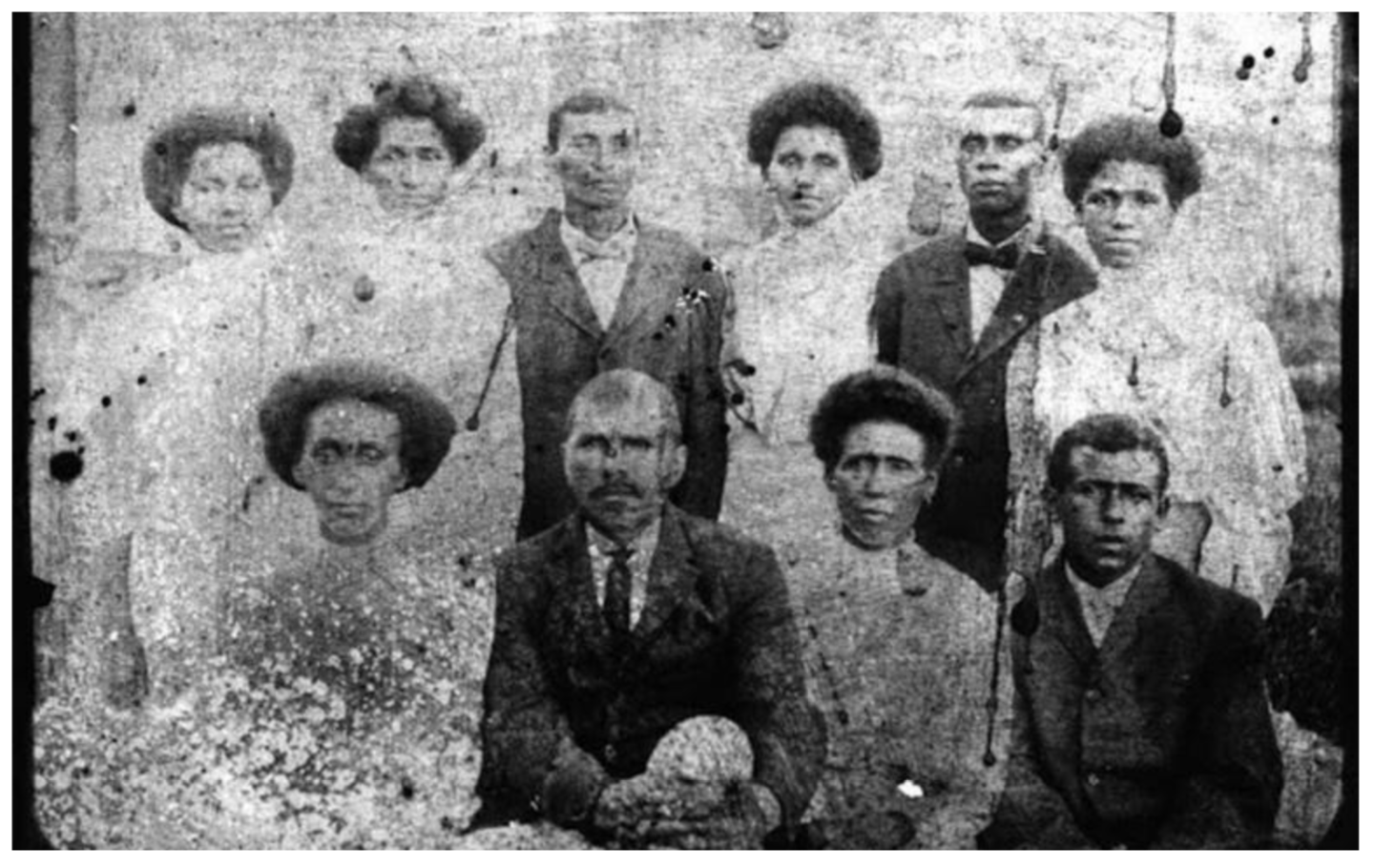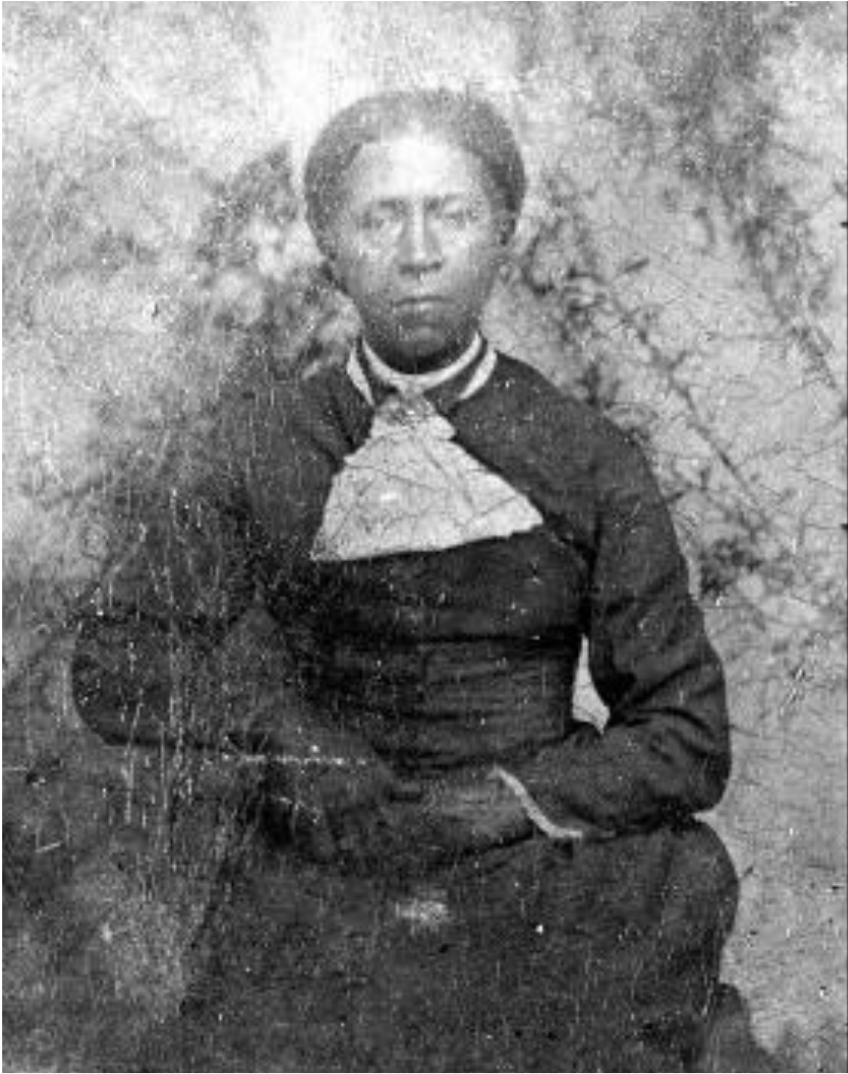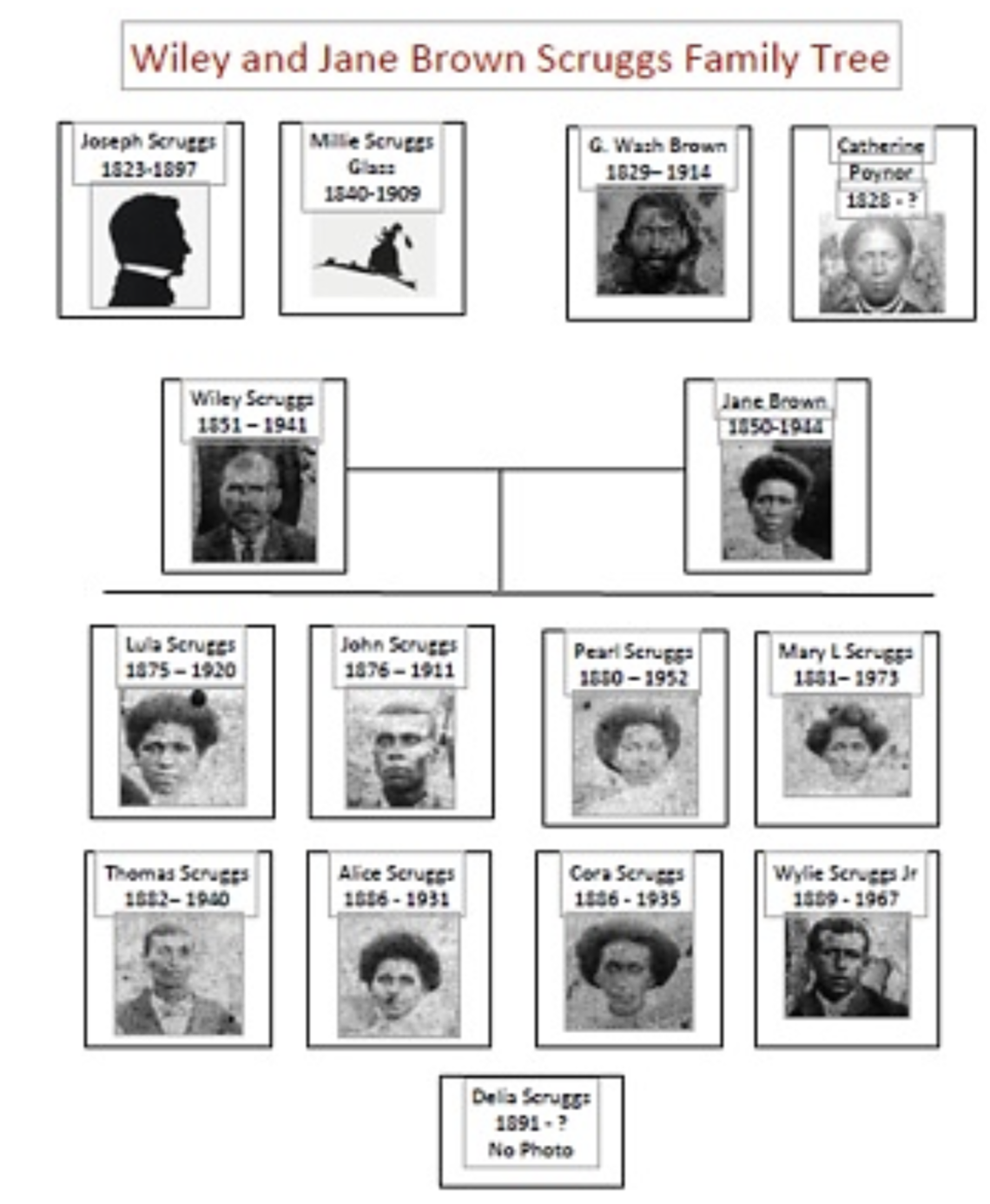THE WILEY & JANE BROWN SCRUGGS FAMILY
2021 Historic African American Pioneer Family
Photograph of the Wiley and Jane Scruggs Family of the Southall community.
Courtesy of the Historical Society of Williamson County.
Wiley Scruggs – 1851-1927
Wiley Scruggs was born on January 27, 1851, in Franklin, Tennessee, to Milly Glass Scruggs, age 11, and Joseph “Joe” Scruggs, age 28. Wiley, a slave was owned by the family of Joe and Angeline Scruggs, near where the poorhouse was in the 1940s (?). He was raised in the house, attended “Miss Angeline’s” needs, set and waited on the table, made fires through the winter and always saw that there was plenty of cool water fresh from the spring.
When asked if he remembered the days of the Civil War he said, “I minds the days of Hood’s Battle of Franklin. . . . we could hear the roar of the battle. The next morning, I came to town with Mr. Joe and saw all the dead soldiers lyin’ round.”
1850 Federal Census Williamson County, Tennessee Joseph and Angeline Bennett Scruggs
Joe and Angeline Scruggs were living in District 5 of Williamson County. Joe was a farmer with $5,000 worth of real estate.
The couple had two young daughters and Angeline’s brother living with them. The family was enslaving 18 people on their farm. The oldest was a 48-year-old man; the youngest was a 1-month-old boy.
1860 Federal Census Williamson County, Tennessee – Slave Census Joseph Scruggs
Ten years later, in 1860, Joe and Angeline Scruggs were still living in District 5 of Williamson County. Joe was a farmer with $12,000 worth of real estate property and $30,000 worth of personal property – including enslaved human beings. The couple had three daughters living with them. Joe and Angeline Scruggs were enslaving 24 people on their plantation. The oldest was a 60-year-old woman; the youngest was a 2-month-old boy. The Scruggs were providing five cabins for them. Wiley Scruggs may be the ten year old boy listed on the census.
Wiley Scruggs Childhood in Slavery
Wiley Scruggs was enslaved by Joseph and Angeline Scruggs. He may have been Joseph Scruggs’ biological son. According to an interview he gave late in his life, “He was raised in the house, attended ‘Miss Angeline’s’ needs, set and waited on the table, made fires through the winter and always saw that there was plenty of cool water fresh from the spring.” Joe and Angeline Scruggs home was located on the land where the Westhaven subdivision sits today. He said before the war he was so stout and healthy his master was offered $1,200 for him. He scratched his head, chuckled and slyly remarked, “I sho’ aint never been worth that much since.”
Local Experiences During the Civil War
During the Civil War, thousands of enslaved people from Williamson County, and across Middle Tennessee, emancipated themselves by fleeing bondage. Many of them sought jobs, food and protection from the federal troops who were occupying the area.
Wiley’s mother Milly was married to Burton Glass
Burton Glass was likely enslaved by the Fielding Glass family who lived across today’s New Highway 96 where Gentry’s Farm is today. Burton had gone to Nashville during the War and was working as a laborer for the federal government building fortifications such as Fort Negley. His name appears on the Employment Rolls and Nonpayment Rolls of Negroes Employed in the Defenses of Nashville, Tennessee, 1862- Burton Glass worked as a laborer to build Fort Negley during the Civil War.
Wiley Scruggs Experiences During the Civil War
Late in life, Wiley Scruggs described to an interviewer a heartbreaking experience that highlights the tension between his desire for freedom and the fear of the unknown.
“At the close of the war his mother [Millie] planned to leave, with the other slaves and told him when she came into the dining room at supper time with the last plate of hot biscuits she would clear her throat and that would be the signal for him to follow her. Instead he crouched in the corner close to his mistress for he said he knew he was getting plenty to eat, where he was and treated well. Where they would go he knew nothing of. His mother made the second trip for him and he still refused to go. As he slept in the “big house” he did not hear the slaves leave in the night but he rose early the next morning and went to the quarters. When he neared his mother’s cabin he could not keep the tears from his childish eyes and wailed, “’Mammy.’ The door opened and there she stood for she could not go off and leave him. At the close of the war, there was 45 of us whites and blacks.”
November 30, 1864 Battle of Franklin
When Wiley was about 12 years old, the ferocious Battle of Franklin occurred just a few miles from him home. He described: “When asked if he remembered the days of the Civil War he said, “I minds the days of Hood’s Battle of Franklin. I was livin’ with Mr. Joe Scruggs, who owned me since I was born. … we could hear the roar of the battle. The next morning, I came to town with Mr. Joe and saw all the dead soldiers lyin’ round, and I wanted to go home.”
Life in Freedom 1870 Federal Census
In 1870, Wiley Scruggs and Jane Brown were counted as free people for the first time in a Federal census. Wiley was 18 years old and living with his mother Milly, her husband Burton, and his younger brother Thomas. Burton was farming and had $200 of personal property – likely livestock and equipment. Wiley and his brother Thomas were working on the farm. They appear to have been living next door to Joe and Angeline Scruggs. At the same time, Jane (Lucinda Jane) was 12 years old and living with her parents. Her father Washington had $275 of personal property.
Jane Brown Scruggs – 1850-1944
Wiley Scruggs’ wife Jane Brown was enslaved by Benjamin Brown and his wife Virginia in the Southall area of Williamson County, Tennessee. She was the daughter of Washington Brown and Catherine Poynor, daughter of craftsman Dick Poynor and his wife Lucinda. “I was a daughter of Wash Brown, who belonged to Mr. Ben Brown.”
Jane Brown Scruggs’ mother Catherine Poynor
Jane Brown’s mother was Catherine Poynor. In an interview late in life, Jane described how, “her mother pieces and quilted 150 quilts and she herself has made close to 100. She displayed some of them giving their patterns, one in red and white she called “Ways of the World.” The reason for the appellation she did not disclose but the work was well done, the stitches small and well placed.”
Catherine Poynor Brown (1828 – unknown)
Marriage of Wiley Scruggs & Jane Brown – 1874
In December 1874, Wiley Scruggs and Jane Brown were married in Williamson County, Tennessee. Their marriage ceremony was solemnized by local Black preacher, teacher and businessman Rev. ANC Williams 1844-1930.
1880s
The year following their marriage, Wiley and Jane Scruggs began their family.
In the 1880 Census, Wiley and Jane were farming. They were raising their three oldest children – Lula, John and Thomas.
According to the Agricultural Census, Wiley and Jane were renting 40 acres for “rents for shares of products.” The value of their farm was estimated at $600 plus $160 worth of livestock. The farm had produced about $590 in crops the previous year.
Among the livestock were 2 milk cows, 3 other cattle, 1 calves
dropped, 1 cow sold live, 3 swine, 7 poultry in the barnyard, and 17 other poultry. The farm produced 35 acres in Indian corn (produced 700 bushels), 5 acres of oats (produced 60 bushels), 5 acres of wheat (produced 111 bushels) and 7 acres of cotton (produced 3 bushels).
1900s
Purchase of Own Farm – In 1898, Wiley and Jane Brown bought their own farm. They purchased 32 acres on Carter’s Creek Pike in the Southall area of Franklin. They paid $1,300 for the land and paid off the mortgage in just three years.
1900 Census – In 1900 the couple was counted in District 5 of the Federal Census. Wiley and Jane had five children living with them – Thomas, Mary Lizzie, Cora, Wiley Jr, and Delia. The ages of their children ranged in age from 21 to 9.
In 1907, Wiley and Jane Scruggs’ daughter Lula moved to Indianapolis, Indiana. She married Samuel Robinson there. He was working in an Iron Foundry and she was a seamstress – perhaps using the quilting skills she had learned from her mother and grandmother. Around 1909, Wiley and Jane Scruggs’ son Wiley Jr married local girl, Dora Degranfenried, and the newlyweds soon moved to Indianapolis, Indiana. (Nashville Globe November 5, 1909)
In 1910, Wiley and Jane Scruggs were living on their farm on Carter’s Creek Pike in a neighborhood full of relatives. The couple reported that they had been married for 35 years. Jane Brown Scruggs had given birth to 10 children, 8 of whom were living.
Wiley and Jane Scruggs’ divorced 33-year-old son John – who was ill with “consumption” or tuberculosis – was living with them. Two doors away was their daughter Mary Lizzie, her husband Jim Cannon and their five young children. Next to the Cannon family was Jane Brown Scruggs’ brother Washington Brown Jr and his family.
During this time, Wiley was recognized as a successful farmer. In an article in the Nashville Globe newspaper (February 16, 1912), he was listed among the Black men in Franklin who were considered leaders:
“Prominent among the farmers in close proximity to Franklin, who own splendid farms of their own, are Messrs. Jack Daws, Tom Mason, Wiley Scruggs, John Gentry and M. Hatcher.”
The Great Migration
In the 1910s, several of Wiley and Jane Brown Scruggs’ children participated in the Great Migration – the movement of large numbers of Black Americans from the South to Northern cities in search of work and opportunities. Three of Wiley and Jane Scruggs’ children moved to Indianapolis, Indiana. Pearl Scruggs and her husband John Smith, Cora Scrugs, and Wiley Scruggs Jr and his wife Dora Degrafanreid were living together at 967 and 965 North Fremont Street in Indianapolis. The men were working as laborers in the nearby Iron Foundry. In 1912, Cora Scruggs married Robert Bland in Indianapolis.
1920s
By the 1920 Federal Census, Wiley and Jane Scruggs were “empty nesters.” They lived alone at their farm on Carter’s Creek Pike. Next door was their daughter Mary Lizzie Cannon and her family.
In the fall of 1920, their daughter Lula Scruggs Robinson died in Indianapolis of peritonitis following a surgery.
Death Certificate for Lula Scruggs Robinson September 16, 1920. Lula Scruggs Robinson’s body was returned to Franklin for burial in the Toussaint L’Ouveture Cemetery.
1930s
In the 1930 Census, Wiley and Jane were living on their farm in Southall. Nearby, daughter Mary Lizzie and her husband Jim Cannon were farming as well. Their son Thomas was living on 4th Avenue North in downtown Franklin with his wife Hattie Mayberry and their children. Thomas worked as a porter at Jennette’s Market and was well-liked.
Wiley Jr had divorced and remarried, and was living in Dallas, Texas where he pastored a Church of God. Several of Mary Lizzie and Jim Cannon’s children (Theresa, Pearl, Lucille, James Jr, and Laura) participated in the Great Migration during this time and moved to Chicago, Illinois. In 1931, Wiley and Jane’s 45 year old daughter Alice Scruggs Halfacre died in Chicago, Illinois.
Primitive Baptist Church – Hard Bargain Neighborhood, Franklin
Wiley and Jane Scruggs belonged to the Primitive Baptist Church in the Hard Bargain neighborhood of Franklin. The Church was famous for hosting large gatherings on the Fourth Sunday in May. Participants engaged in ritual foot washing ceremonies that were part of day-long celebrations. In an interview in 1941, it was described how: The aged couple belongs to the Primitive Baptist Church and both were present on the fourth Sunday in May at the foot-washing at Hard Bargain Church.
1940s
On April 1, 1940, Wiley and Jane Scruggs were counted in the Federal Census. As they had been counted for the past two decades, the couple was living in their home on Carter’s Creek Pike, which was valued at $700. Their daughter Pearl was living with them. Living at 327 9th Avenue in the Hard Bargain neighborhood of Franklin was their son Thomas and his family. On October 9th, 1940, Thomas died at Vanderbilt University.
Legacy of Education
Wiley and Jane Scruggs’ granddaughters Jane Mai Cannon and Laura Cannon worked as teachers in the segregated, all Black Schools in Williamson County.
December 7, 1941 Death of Wiley Scruggs
Wiley Scruggs died at his home in the Southall area of Franklin. According to his death certificate, he was buried in Franklin’s Toussaint L’Ouverture Cemetery. According to a map of sold plots, Wiley Scruggs and his brother Tom Glass had purchased a “family square” in the Cemetery and he may be buried there.
May 25, 1944, Jane Brown Scruggs
Jane Brown Scruggs died at her home in Southall of liver cancer. Well-known Black physician Charles C. Johnson had treated her for several months before her death. She was 86 years old. The local Patton Brothers funeral home handled her service. She was buried in the historic Toussaint L’Ouveture cemetery along with her late husband Wiley. No headstones for either of them have been located.



